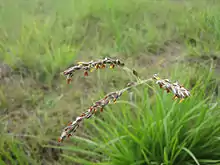| Black seed grass Cockatoo grass | |
|---|---|
 | |
| Scientific classification | |
| Kingdom: | Plantae |
| Clade: | Tracheophytes |
| Clade: | Angiosperms |
| Clade: | Monocots |
| Clade: | Commelinids |
| Order: | Poales |
| Family: | Poaceae |
| Subfamily: | Panicoideae |
| Genus: | Alloteropsis |
| Species: | A. semialata |
| Binomial name | |
| Alloteropsis semialata | |
| Synonyms[1] | |
| |
Alloteropsis semialata, known commonly as black seed grass, cockatoo grass, donkersaad gras, swartsaadgras, tweevingergras, and isi quinti, is a perennial grass distributed across much of tropical and subtropical Africa, Asia and Australia, as well as Papuasia and Madagascar.[1][2][3] The genus name Allopteropsis comes from the Greek words "allotrios", meaning "belonging to another", and "opsis", meaning appearance. The specific epithet semialata comes from the Latin "semi" (half) and "ala" (wing), referring to the winged margins of the upper glume.[4]
Description
This plant typically reaches 20-150 centimeters tall, growing from a short, white rhizome.[5] The leaf blades are typically 10-50 centimeters long and 1-10 millimeters wide. The plant produces 2-flowered fertile spikelets.[6]
Variation
The species has two subspecies including A. semialata subsp. semialata, which uses the C4 photosynthetic pathway, and A. semialata subsp. eckloniana, which uses the C3 photosynthetic pathway.[7] As the only plant species known to use both pathways, it is an important model for the study of the evolution of photosynthesis. There are a wide range of intermediate phenotypes, including that of C2 photosynthesis.[8]
The species has been found in a polyploid series with diploid, tetraploid, hexaploid, octoploid and dodecaploid individuals. All members of the C3 subspecies are diploid and there are no diploid individuals outside of that subspecies.[9]
Ecology
The seeds of this species are an important component of the wet-season diet of many granivorous finches and parrots. The rhizomes are part of the dry-season diet of some animals.[4]
References
- 1 2 Kew World Checklist of Selected Plant Families
- ↑ Flora of China Vol. 22 Page 519 毛颖草 mao ying cao Alloteropsis semialata (R. Brown) Hitchcock, Contr. U. S. Natl. Herb. 12: 210. 1909.
- ↑ Hitchcock, A. S. 1909. Catalogue of the Grasses of Cuba. Contributions from the United States National Herbarium 12(6): 183–258, vii–xi
- 1 2 "Cockatoo Grass – Alloteropsis semialata | NQ Dry Tropics". Retrieved 2021-05-07.
- ↑ "Alloteropsis semialata". Cape York Natural Resource Management. Retrieved 2021-05-07.
- ↑ "Alloteropsis semialata | AusGrass2". ausgrass2.myspecies.info. Retrieved 2021-05-07.
- ↑ Gibbs Russell, G. E. (1983). "The taxonomic position of C3 and C4 Alloteropsis semialata (Poaceae) in southern Africa". Bothalia. 14 (2): 205–213. doi:10.4102/abc.v14i2.1160.
- ↑ Lundgren, Marjorie R.; Dunning, Luke T.; Olofsson, Jill K.; Moreno-Villena, Jose J.; Bouvier, Jacques W.; Sage, Tammy L.; Khoshravesh, Roxana; Sultmanis, Stefanie; Stata, Matt; Ripley, Brad S.; Vorontsova, Maria S.; Besnard, Guillaume; Adams, Claire; Cuff, Nicholas; Mapaura, Anthony; Bianconi, Matheus E.; Long, Christine M.; Christin, Pascal-Antoine; Osborne, Colin P. (February 2019). "C4 anatomy can evolve via a single developmental change". Ecology Letters. 22 (2): 302–312. doi:10.1111/ele.13191. PMC 6849723. PMID 30557904. S2CID 56174713.
- ↑ Liebenberg, E. J. L.; A. Fossey. (November 2001). "Comparative cytogenetic investigation of the two subspecies of the grass Alloteropsis semialata (Poaceae)". Botanical Journal of the Linnean Society. 137 (3): 243–248. doi:10.1111/j.1095-8339.2001.tb01120.x. S2CID 84546752.